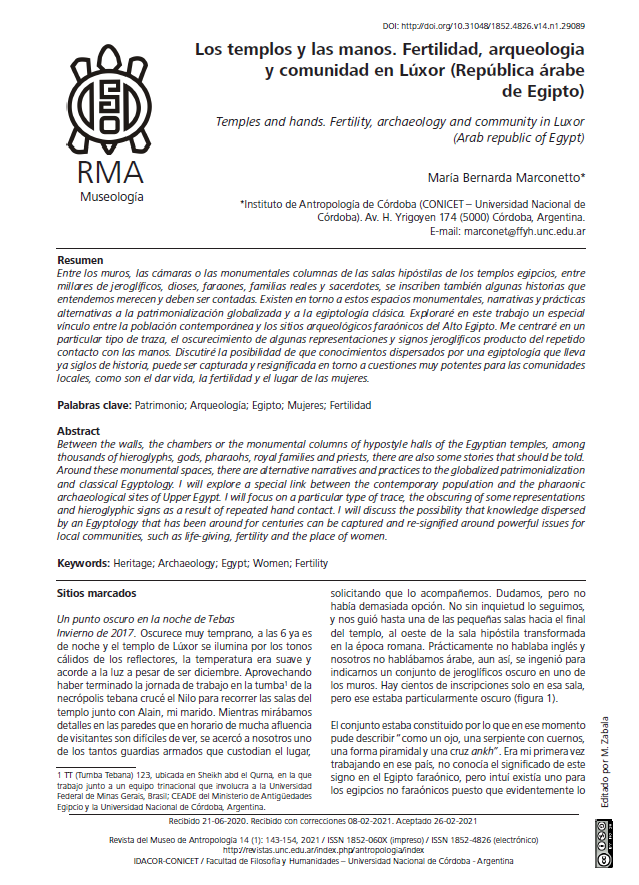Temples and hands: touch and contact between pharaonic and contemporary Egypt
DOI:
https://doi.org/10.31048/1852.4826.v14.n1.29089Keywords:
Heritage, Archaeology, Egypt, Women, FertilityAbstract
Among the monumental columns and hypostyle rooms of the Egyptian temples, among thousands of hieroglyphs, gods, goddesses, pharaohs, royal families and priests, there are also some minimal stories that deserve and should be told. Exists around these monumental spaces, narratives and alternative practices to the global heritage and classical Egyptology, mediated by the actions of people who affect and are affected by these spaces. In this work, I will explore a special link between the contemporary population and the Pharaonic archaeological sites, in the area that currently comprises the Luxor Governorate (Arab Republic of Egypt). I will focus on a particular type of trace, the darkening of some hieroglyphs product of repeated hand contact. I will discuss the possibility that knowledge dispersed by an Egyptology that has been around for centuries, is captured and resignified by very powerful issues for that community such as giving life, fertility and the place of women.
Downloads
References
Arroyo de la Fuente, María Amparo (2011) La protección divina de la maternidad en Egipto. En: Fernández Uriel, P., Rodríguez López, M. I. Iconografía y sociedad en el Mediterráneo Antiguo. Homenaje a la Dra. Pilar González Serrano. Ed. Signifer, Salamanca, España.
Atiya, Nayra (1984) Khul-Khaal. Five Egyptian women tell their stories, The American University in Cairo Press, Cairo, Egipto.
Blackman, Winifred S. (2000) [1927] The fellahin of Upper Egypt. The American University in Cairo Press, Cairo, Egipto.
Chelhod, Joseph (1955) La baraka chez les Arabes ou l’influence bienfaisante du sacré. Revue de l’histoire des religions, 148 (1): 68-88
Guber, Rosana(2001) La etnografía. Método, campo y reflexividad,Grupo Editorial Norma, Bogotá, Colombia.
Hell, Bertrand (2002) Le tourbillon des génies au Marroc avec les Gnawa, Flamarion, Paris, Francia.
Leblanc, Christian (2015) La mémoire de Thèbes. Fragments d´Egypte d´hier et aujourd´hui, L´Harmattan, Paris, Francia
Leblanc, Christian (2018) La sainte montagne de Thèbes et Ghourna. Revue Égypte, Afrique & Orient, supplement 7.
Maspero, Gaston (1910) Ruines et paysages d’Egypte, E. Guilmoto, Paris, Francia.
Pellini, José Roberto(2013) Arquelogia, revolução e falafel. A arqueología egípcia e a primavera árabe. Revista do Museu de Arqueologia e Etnologia, 23: 155-170.
Pellini, José Roberto (2018) Senses, affects and archaeology. Changing the heart, the mind and the pants, Cambridge Scholars Publishing, New Castle, Reino Unido.
Perrin, Emmanuelle (2004) Folklore et ethnographie de l’Egypte contemporaine: Le “Dictionnaire des coutumes, des traditions et des expressions égyptiennes” (Qâmûs al-’adâtwa-l-taqâlîdwa-l-ta’âbîr al-misriyya) de Ahmad Amîn, Institut National des Langues et Civilisations Orientale, Paris, Francia.
Radi, Saâdia (2014) Surnaturel et société. L’explication magique de la maladie et du malheur à Khénifra, Maroc, Centre Jacques-Berque, Rabat, Marruecos.
Schumann Antelme Ruth y Stephane Rossini (1999) Les secrets d´Hathor. Amour, erotisme et sexualité dans l´Egypte pharaonique, Editions du Rocher, Montecarlo, Monaco.
Simpson Caroline (2001) Qurna who’s a wit where, when and why? Fourth biennial conference of the Association for the study of travel in Egypt and Near East.
Simpson Caroline (2010) Qurna: more pieces of an unfinished history. En: Z. Hawas y S. Ikram (eds)Thebes and Beyond: Studies in honour of Kent R. Weeks, Supreme Council of Antiquities, Cairo, Egipto.
Van der Speck, Kees (2007) Feasts, fertility and fear: Qurnawi spirituality in the ancient Theban landscape. Proceedings of the Theban workshop. Sacred space and sacred function in ancient thebes. Studies in ancient oriental civilizations, 61: 177-192
Van der Speck, K. (2011) The modern neighbors of Tutankhamon. History, life and work in the villages of the Theban West Bank. The American University of Cairo Press, Cairo, Egipto.

Downloads
Published
Issue
Section
License
Copyright (c) 2021 María Bernarda Marconetto

This work is licensed under a Creative Commons Attribution-NonCommercial-ShareAlike 4.0 International License.
Those authors who have publications with this Journalaccept the following terms:
a. Authors will retain their copyrights and guarantee the journal the right of first publication of their work, which will be simultaneously subject to the Creative Commons Attribution License (Licencia de reconocimiento de Creative Commons) that allows third parties to share the work as long as its author and his first publication in this journal.
b. Authors may adopt other non-exclusive licensing agreements for the distribution of the version of the published work (eg, deposit it in an institutional electronic file or publish it in a monographic volume) provided that the initial publication in this journal is indicated.
c. Authors are allowed and recommended to disseminate their work on the Internet (eg in institutional telematic archives or on their website) before and during the submission process, which can lead to interesting exchanges and increase citations of the published work. (See The Effect of Open Access - El efecto del acceso abierto)











